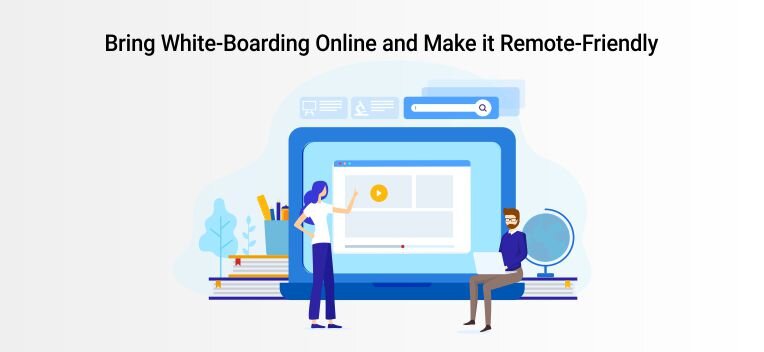Here’s a Few Tips on How to Manage a Remote Employee.
The most challenging task for employers nowadays is to recognize potential candidates and to hire the right person who can get your job done accurately. In this competitive market, it is tough to choose and retain the best developers for your enterprise. Even though remote hiring was once subject several misconceptions, they have now become a vital asset for employers to meet their goals. Working with your remote team members can seem to be an exciting job, but one needs to be well aware of the challenges that come with it. Remote hiring has increased by 140% since 2005, which is nearly ten times faster than the rest of the workforce. According to the Global Workplace Analytics, 3.2% of the workforce, now, work from home. Remote hiring is undoubtedly the ultimate work scenario for many employees, but it can sometimes become difficult for managers to work out how to manage a remote employee efficiently. Even though the acceptance for remote hiring is growing nowadays, there are specific challenges that you need to address smartly. You need to understand these challenges and work through them to improve engagement, productivity, and cohesion in your team.
We Have Some Tips That Will Help You Manage a Remote Employee Efficiently.
Hire The Right People
The truth be told, not everyone can be a remote employee. Everyone realizes the perks, comforts and convenience of working remotely. But only a few have the approach, attitude and discipline to be productive as remote employees. You need to identify people who have the potential to work independently and sincerely. Efficient remote workers have a positive attitude and motivation to do their jobs well. An excellent remote employee will not sit idle or wait for you to ask for task updates or assign tasks. He or she will have a proactive attitude and will keep updating you on the work schedule. The best places to find remote professionals would be LinkedIn, Upwork, Toptal, Hivedesk, Fiverr and GlobalEmployees. Once you have a remote team in place you need to keep in mind a few things that would help you manage a remote employee in a productive way.


You must show examples of the kind output you want and expect. Remember! The more prepared they are, the better they can serve! Set clear expectations and timelines. They must know how you will measure their output and what all they need to do to meet the assigned goals on time.

You must assign and engage your remote employee with daily work through daily communication. You cannot create a gap. Try using multiple channels to communicate and try to plan a regular face-to-face meeting. Constant interaction helps remote workers feel included. They are an essential aspect of your organization and must never forget that, and also not let them forget.

It is essential, particularly with virtual employees, to schedule time and look at one another when speaking. If there is no face-to-face communication, silence can become deafening. Remote employees may be left wondering whether they are on the right track or are they working well enough.

We often make the mistake of relegating our remote staff into secondary consideration. It can be rectified using virtual meetings and staff partnerships. Assign your remote team with a local point of contact where communication and connection are valued. Try to make them a part of the successes and achievements of your company.

In the case of remote workers, unlike office workers, they do not get a chance to enjoy regular-office interaction. It is why on-target communication becomes critical. You need to align their mission and communicate through values that are truly important to them. You must determine and understand their natural roles and tendencies in any situation so that you can handle them better. It will keep them motivated, keep their productivity high and also you will win a long-term work relationship.

Often remote employees face problems like they fail to download files or they struggle to hear appropriately on conference calls or consistently receive meeting invitations may be at times when they are resting or are asleep. To sort this out, you need to use reliable tools to facilitate smooth collaboration.

When you use a remote workforce, you must stay focused on your own goals and also the goals you have set for your employee. You don’t need to look much into what he is doing and how. Instead, concentrate on whether you are achieving your goals or not. If they are accomplishing your goals, then you should remain confident about your employee and his work-efficiency. If not, you need to take some steps, because you cannot let an employee be the reason behind your loss. It is all about accomplishment and not the activities done. It could be your way or your employee’s way. As long as your work is getting done, you must be up for it!

Once you begin working with remote employees and start expanding your reach, you will soon have people from across many time zones. It makes scheduling meetings a tough job. There is always a chance for you to call one or two of them at awkward and inconvenient times. You need to schedule your meetings such that you maintain that you do not call the same employees at unfavorable times. Distribute the difficulties equally.

The employees nowadays are more interested in advancing their skills rather than gaining stability. The idea of working years after years for one single company is disappearing. We don’t get to see it anymore. You need to show personal interests in the life goals of your remote team. Take a moment to connect their interests with the goals of your company. This way, both sides can benefit.

You must build good rapport with every employee of your remote organization. It will help you sort out problems any team member is facing. Ideas and opinions never go waste. If you have good rapport with your employees, they can communicate with you in case they feel you have made a mistake or taken an unsuitable decision.

Managing a remote employee efficiently would require you come up with a clear plan. First, arrange weekly ‘report-ins’ and then set guidelines about daily needs. There must be an understanding of what is urgent, and the priorities must be set right.

What is your favorite part of remote-working?
What daily routine do you follow to do your work?
Do you feel included in our team decisions?
Are the tools we use to communicate with you remotely, working fine with you?
Do you think that you need to connect more with any of your co-workers, particularly? How would you benefit from that?
You visit the office ten times in a year. Is that too often for you, or do you want to pay more visits?

Try to shift all kinds of brainstorming in the digital space. Remote employees face a disadvantage when it is about sharing and bouncing ideas. Try to use such tools so that your remote employees can be a part of your office meetings too.

You must have the intention to prepare your remote employees for the remote-workforce culture. It is your responsibility to make each team meet count and make them contribute and add value in various possible ways.

Give remote employees easy access to you so that they can reach you whenever they need you, just like your office-employees can. They must not feel segregated. You need to give them equal importance as you give to your local employees. Your local employees get to see you and communicate with you directly every day in person. The remote employees do not have that access and can feel distant. It can cast a negative effect on their morale. So, you cannot let that happen!

We often see that some companies are reluctant to embrace a remote employee. It is because their remains a doubt about whether or not the employee is going to work as hard and complete his work on time, as he would if he worked at the office. But, this is where you go wrong! To do away with this obstruction, you need to set relevant work from home guidelines for your employees. Examples: 1) They need to respond to e-mails within 24 hours. 2) Text messages are preferable for urgent matters.3) No calls between certain hours to ensure that your employee is not working around the clock.

You should never cancel a one-on-one meeting with your remote employees. They will agree if you ask, but it is more a matter of the power dynamic between the manager and his employee. Remote employees miss out on a lot of information that gets naturally communicated in your office. It could be announcements or other brief news. One-on-one meetings help you manage all the little things that build within a week. With so much to look after, you should not risk missing one for these team members.
Client Testimonials
Since our inception in 2012, we have had an amazing journey working with many clients from various business domains. Here’s what some of them say about us…










The Overall Process To Hire A Remote Employee Usually Takes 1-2 Weeks From The Time You Convey The Requirements.
Fill Out The Form Below And A Representative Will Contact You Within 24 Hours.
Get Free Sample Resumes & Consultation. Speak To Our Hiring Managers About Your Requirements.
We Understand & Respect Your Privacy. Your Details Are Only Shared With Our Hiring Managers To Get In Touch With You.
